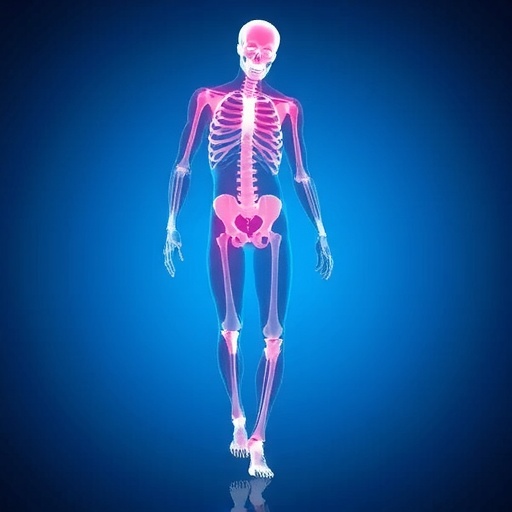A groundbreaking study recently published in Acta Pharmaceutica Sinica B unveils an innovative and highly efficient platform for the discovery of anti-Notum compounds derived from herbal medicines, establishing a novel therapeutic pathway for combating glucocorticoid-induced osteoporosis (GIOP). This research not only highlights the therapeutic potential of natural compounds against a challenging bone metabolic disorder but also integrates advanced biochemical and computational technologies to expedite drug discovery.
Notum, an extracellular carboxylesterase, has recently garnered significant attention as a critical negative feedback regulator of the Wnt signaling pathway. Given Wnt signaling’s pivotal role in osteoblast differentiation and bone homeostasis, Notum emerges as an attractive target for therapeutic intervention in diseases characterized by impaired bone formation. In particular, glucocorticoid-induced osteoporosis, a common side effect of prolonged glucocorticoid therapy, negatively affects bone density and structural integrity, necessitating new treatment options.
At the heart of this study lies a smartly engineered near-infrared (NIR) fluorogenic substrate for Notum, designed specifically for rapid, high-throughput screening of natural products. This substrate enables the sensitive and efficient identification of Notum inhibitors from complex herbal extracts without the interference commonly encountered with conventional assays. The development of this NIR fluorogenic probe marks a significant advancement, facilitating a streamlined screening process with enhanced specificity and sensitivity.
Applying this cutting-edge assay, the research team systematically screened a diverse library of herbal medicines traditionally used for osteoporosis treatment. Among these, Bu-Gu-Zhi (BGZ), an ancient herbal formulation known for its bone-strengthening properties, stood out due to its potent inhibition of Notum enzymatic activity. Subsequent kinetic analyses revealed that BGZ acts in a competitive manner, restricting substrate binding within Notum’s catalytic pocket.
To further dissect the active constituents responsible for BGZ’s anti-Notum properties, the researchers adopted an integrative approach combining biochemical assays, phytochemical isolation, computational docking, and in vivo pharmacology. This multidisciplinary strategy ensured the precise identification and validation of key molecules while elucidating their mechanisms of action.
Three furanocoumarin derivatives prominently emerged as potent inhibitors within BGZ’s complex chemical matrix. Among them, 5-methoxypsoralen (5-MP) demonstrated the most robust inhibition coupled with an exceptional safety profile, making it a prime candidate for therapeutic development. Computational modeling provided molecular insights, revealing that 5-MP exerts its effect as a competitive inhibitor by lodging within the catalytic cavity of Notum, stabilized through hydrophobic interactions mainly with residues Trp128 and Phe268.
Corroborating these findings, cellular assays on MC3T3-E1 osteoblast precursors under dexamethasone-induced stress showed that 5-MP robustly restores osteoblast differentiation and Wnt pathway activation, effectively counteracting the glucocorticoid-mediated suppression. These cellular effects underscore the compound’s capability to reverse the impaired osteogenic signaling crucial for bone regeneration.
Moreover, the promise of 5-MP extends beyond cellular models into animal studies. In dexamethasone-induced osteoporotic mice, administration of 5-MP significantly increased bone mineral density (BMD) and enhanced both cancellous and cortical bone thickness. These morphological improvements were indicative of functional bone restoration, validating 5-MP’s potential as a disease-modifying agent rather than a symptomatic treatment.
This study not only advances our understanding of the molecular interplay between herbal constituents and enzymatic targets in bone pathology but also sets a new benchmark for drug discovery methodologies. By synergizing high-throughput biochemical screening with state-of-the-art computational and pharmacological evaluations, the research delineates a rapid and reliable pipeline that could be translated to other natural product-derived drug discovery efforts.
The implications for treating glucocorticoid-induced osteoporosis are significant. Current therapies largely focus on either inhibiting bone resorption or stimulating bone formation nonspecifically, often accompanied by adverse effects. Targeting Notum presents a specialization that directly modulates a key signaling axis essential for osteoblast function, promising better efficacy with fewer side effects.
In addition to its therapeutic value, 5-MP’s origin as a natural product provides favorable safety and tolerability parameters, often elusive in synthetic agents. Its known existence in traditional medicines potentially expedites regulatory paths and public acceptance, factors critical for translational success.
To summarize, this pioneering research sheds light on a potent natural compound, 5-methoxypsoralen, as a competitive and selective Notum inhibitor with multifaceted benefits in reversing glucocorticoid-induced bone loss. The combination of innovative assay development, integrative chemical biology, and robust translational validation marks a noteworthy leap forward in osteoporosis research.
With osteoporosis forming a growing global health concern, particularly among aging populations subjected to chronic glucocorticoid therapy, these findings resonate as a beacon of hope. The discovery not only reinforces the value of herbal medicines in modern pharmacology but also inspires new directions in therapeutic design leveraging endogenous signaling modulations.
Future research pursuing clinical evaluations of 5-MP and optimization of its pharmacodynamic and pharmacokinetic properties could pave the way for novel, safe, and effective treatments against glucocorticoid-induced osteoporosis, possibly expanding to other Wnt-associated bone disorders. This study exemplifies the marriage of traditional knowledge and cutting-edge science to address pressing medical needs.
Subject of Research: Discovery of anti-Notum natural compounds from herbal medicines for therapeutic use in glucocorticoid-induced osteoporosis.
Article Title: High-efficient discovering the potent anti-Notum agents from herbal medicines for combating glucocorticoid-induced osteoporosis.
News Publication Date: 2025
Web References:
Keywords: Notum, Near-infrared fluorogenic substrate, High-throughput screening, Glucocorticoid-induced osteoporosis (GIOP), 5-Methoxypsoralen, Wnt signaling, Osteoblast differentiation, Herbal medicines, Competitive inhibition, Bone mineral density.




